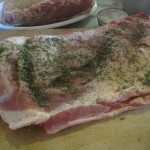 Years ago in Tuscany and most of Italy, before fresh meat was readily available for purchase in the grocery store or a butcher shop, fresh meat was rare on the common dinner table. Roasted and braised meats or grilled steaks were only available during the hunting season or in the winter when the pigs were butchered. The rest of the year it was vegetables, bread and pasta, and the protein options were cured meats like salami, prosciutto or pancetta, with the occasion chicken or rabbit for Sunday dinner and special occasions.
Years ago in Tuscany and most of Italy, before fresh meat was readily available for purchase in the grocery store or a butcher shop, fresh meat was rare on the common dinner table. Roasted and braised meats or grilled steaks were only available during the hunting season or in the winter when the pigs were butchered. The rest of the year it was vegetables, bread and pasta, and the protein options were cured meats like salami, prosciutto or pancetta, with the occasion chicken or rabbit for Sunday dinner and special occasions. 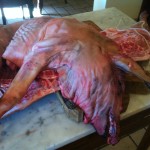
January and the winter months were traditionally the time that the pigs were slaughtered, when the cold weather would keep the meat from spoiling before it had a chance to begin to cure. Hams, necks, and bellies and were salted and laid down to become 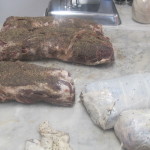 prosciutto, capocollo and pancetta. The head was boiled in spices and lemon and picked over to be made into soppressata. All the rest was chopped and ground to be made into sausages, cured in olive oil, or salami, mixed with fennel, garlic and black pepper.
prosciutto, capocollo and pancetta. The head was boiled in spices and lemon and picked over to be made into soppressata. All the rest was chopped and ground to be made into sausages, cured in olive oil, or salami, mixed with fennel, garlic and black pepper.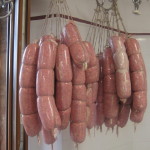
All that is still done, but in modern, temperature controlled facilities on a year round basis. The seasonality of the pig slaughter has mostly disappeared and with it the appreciation of the rarity of a great chunk of roasted loin, shoulder or pork belly.
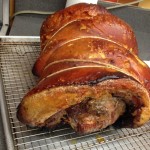 During my first winter in Tuscany, one of my most exciting discoveries was roasted pork belly, or pancetta fresca arrosto. To me, the best part of roasted pork was always the fat on the outside, and the cuts had become so lean and dry in the US it had lost its appeal. But all that fat, hot and roasted, with the skin brown and crunchy, was sheer heaven.
During my first winter in Tuscany, one of my most exciting discoveries was roasted pork belly, or pancetta fresca arrosto. To me, the best part of roasted pork was always the fat on the outside, and the cuts had become so lean and dry in the US it had lost its appeal. But all that fat, hot and roasted, with the skin brown and crunchy, was sheer heaven.
Pancetta in Italian comes from pancia, which is the belly of the pig, 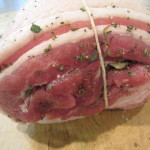 and can be cured, smoked or raw. The first time I saw a large slab of raw pancetta in the butcher window, rolled and stuffed with rosemary and sage, I knew I’d found dinner.
and can be cured, smoked or raw. The first time I saw a large slab of raw pancetta in the butcher window, rolled and stuffed with rosemary and sage, I knew I’d found dinner.
The pancetta can be rolled on it’s own or rolled around a pork shoulder. 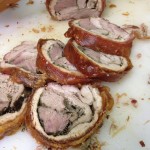 Because the pork belly must cook at a high temperature until it’s crunchy and thoroughly cooked, it’s unwise to roll it around a pork loin, which will overcook and become dry.
Because the pork belly must cook at a high temperature until it’s crunchy and thoroughly cooked, it’s unwise to roll it around a pork loin, which will overcook and become dry.
The easiest way to cook a pork belly, is just to salt it and put it on a bed of sage and rosemary sprigs and whole garlic cloves. Add some white wine to the pan and put it in a really hot oven, at 425-450, until it’s gorgeous with a brown crunchy skin and the juices from the fat running out and making your mouth water. Take it out and put it on a large cutting board for 10 minutes. Chop it with a large chef or butcher knife and serve it with sauteed fennel and winter greens, roasted potatoes and good bread.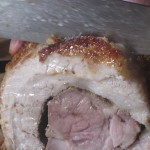
You can also get a pork roast and roll the pork belly around it. Salt the shoulder, rub it all over with a paste of fresh rosemary, sage and garlic, and wrap the pancetta around it, skin and fat side out. Tie the roast well and follow the above roasting instructions.
Enjoy the winter! Buon Appetito!
Leave a Reply